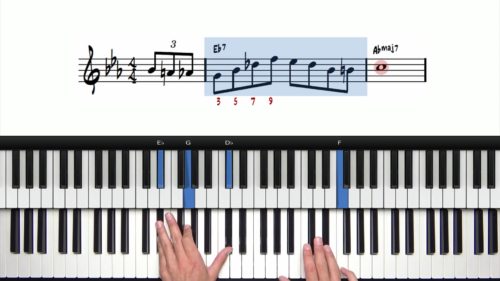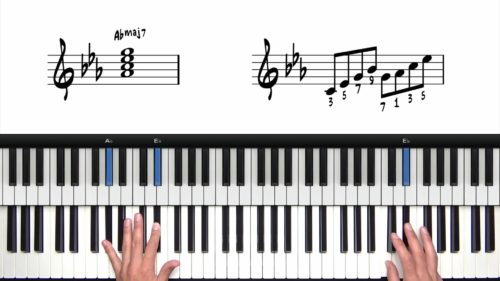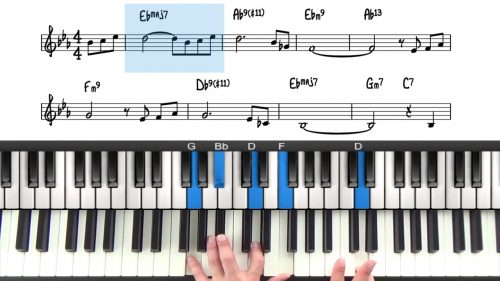Arpeggio Runs & Fills
In this lesson we explore arpeggio runs and fills that we can use to fill in the space when the melody rests, and also to connect the melody line played in different octaves.
Connect The Octaves with Fluidity
Previously we have explored playing the melody in the middle register of the piano, the higher register of the piano, and also with octave melody lines. This lesson will show you a useful technique to connect these registers together so that you can decide to change the register of the melody at any point during the performance.
Lesson Downloads
-
Arpeggio Runs & Fills File Type: pdf
Practice Tips
-
Keep in mind the melody note when adding arpeggio fills and find an inversion of the chord/arpeggio which keeps that melody note on top.
-
First experiment with the primary chord tones which are 1-3-5-7. Next add colour tones such as 9ths which can create more interesting arpeggio shapes.
-
Utilise chromaticism and approach patterns to connect an arpeggio to the next chord and the melody note written on the lead sheet.








Hi Hayden. After lots of practice I have managed to be able to play through The Nearness of You using stride for the left hand. As stride was brand new for me, I simplified things by basically playing the stride positions you had in the first 3 lessons with one or two notes in the bass on beats 1 and 3, then the 3rd and 7th in the left on beats 2 and 4. I combined this with using the very basic melody in the right hand from the Nearness lead sheet. I figured I could add the extra touches you had in the A, B and C Section-Melody-Shells-Stride-Transcription pdfs once I had the essentials down.
Here’s my question. I realise that what I’ve done basically is memorise the right hand melody so that while I am playing the song I am mostly glancing to my left to get the stride correct. Now I want to tackle the later lessons where you show arpeggios, improvisation, etc. in the right hand. I don’t know if it’s a good idea, for example, in the pdf for the lesson on Arpeggio-Runs-Fills to memorise the right hand you show in the pdf. I would think the goal is to be able to get to the point where you could add in an arpeggio, etc. without having memorised it.
Sorry for the long description but basically I’m asking how I can keep the stride left hand going while being able to look and concentrate on the right hand more.
Hi Greg,
Apologies for the late reply and great question!
In the 2nd module of this course we look at the 3 left hand accompaniment techniques:
– stride left hand
– shell voicings (often root and 7, or root, 3 and 7).
– 10th intervals (the 5th or the 7th can be played with the left hand index finger)
When I’m playing ballads, I naturally mix these left hand styles together.
When I’m adding melodic embellishments, I don’t play the stride on every measure/every chord. If my right hand is busy melodically, for example with an arpeggio run, I will usually opt for a more ‘static’ voicing in my left hand such as a shell voicing or a 10th interval.
However, when I play these ‘static voicings’ I do still outline the quarter note pulse by repeating some of the notes, so it has a similar effect to the stride style in that it is creating a pulse.
Please watch this lesson and check out chapter 2 “Altered Lines For F7 Chord” pianogroove.com/jazz-piano-lessons/alterations-altered-lines/ – and in particular around 5m40s you will see that I play an F7 10th interval voicing (F-Eb-A) whilst my right hand is playing the busy and fast fingered arpeggio run. But I still outline the pulse in my left hand.
For this sequence over the F7, we could absolutely play stride in our left hand, but it’s more challenging because the right hand is playing a fast run down the piano.
That should help to answer your question here.
The other side of the coin is simply playing/practicing the stride pattern so many times that the movements become ingrained in our muscle memory and we can play the stride without needing to look at our left hand too much. After playing these songs for many years, for example I have been playing this tune for perhaps 8 years or so, this naturally happens. I know that’s not really the answer you’re looking for, so experiment with the guidance above on left hand voicing configurations, but also keep in mind that most jazz and blues concepts become ‘easy’ and ‘2nd nature’ just through lots of repetition over the years.
—-
To answer your other question regarding memorising right hand fills, yes this is a good idea.
I actually hosted 2 seminars earlier this month where we focused on Diminished Scale Runs, and Altered Scale Runs, you can find them here and they are very much related to this course and your question:
pianogroove.com/live-seminars/diminished-scale-runs-fills-improvisation/ (we cover “Nearness Of You” around 50 minutes into the seminar)
pianogroove.com/live-seminars/altered-scale-runs-fills-improvisation/ (we cover “Nearness Of You” throughout this seminar)
In the 2nd seminar I demonstrate how to take an altered scale line/run, identify the interval pattern, for example #9 to b9 to #5 to 3 – this pattern then repeats – and drills to take this around all 12 keys. See around 30 minutes to the 45 minute mark in the 2nd seminar where I show some drills to learn these patterns in all 12 keys.
Once you have taken a pattern like this around all 12 keys, it will be ingrained in your playing, and you will be able to use it on-demand.
Personally I extremely rarely, if ever use(d) transcriptions. I added them to the site because students requested them, but the best thing that you can do to internalise these fills is to identify an arpeggio pattern in one key, and then transpose it around all 12 keys – as I demonstrate in the 2nd seminar. The first time you do this is the hardest, and each subsequent time you do this with a different melodic idea, it becomes easier and easier as you start to be able to visualise patterns, lines, licks, motifs, etc… in any key.
—-
In summary, it’s a balance between the right and left hand. If my right hand is static or not much melodic movement, I will often add interest by playing a stride left hand. If my right hand is playing a very busy and/or complex fill or arpeggio, I will often opt for a simpler left hand structure such as a shell or 10th voicing.
—-
I hope that helps Greg – check out the links I reference above and it should help to illustrate my explanations here.
P.S. As Stride was brand new to you before this course, it is natural to find it tricky. The key is simply lots and lots of repetition, also practice on different tunes.
The tune “Georgia” has very similar chord changes to “Nearness Of You” and so by practicing that tune you will indirectly be improving your stride skills over “Nearness Of You”. Here’s the course on that tune: pianogroove.com/blues-piano-lessons/bluesy-stride-piano-beginners/ – I think you will also enjoy this course so check it out!
Thanks for the very thorough answer, Hayden!
Hi Hayden. Another question for you. I’ve been working on the Arpeggios Runs and Fills lesson and have been having a lot of difficulty playing the arpeggios, most of which are demisemiquavers with any kind of speed or dexterity. Are there any courses, seminars, etc. on the site which give some guidance on techniques for getting arpeggios up to speed?
Hi Greg,
Good question.
This is the most relevant lesson is where I explain how to play arpeggio fills in this style. I do cover them in the cocktail piano improvisation course here: pianogroove.com/jazz-piano-lessons/arpeggio-shapes-patterns/ – and in this lesson we are playing arpeggios at a slower tempo.
The only technique for getting anything ‘up to speed’ is starting at a tempo that we are comfortable with and gradually increasing the tempo. So I’d recommend to find whatever tempo that is and take it from there. Isolate the right hand fills that I am using and play them slowly and accurately, then gradually speed up.
I am playing ‘rubato’ in this course (as this is how I play jazz ballads) and so whilst my left hand is keeping the pulse, I do speed up and slow down in certain places. This is one of the liberties that we have when playing solo piano.
One thing to pay attention to is that when I play an arpeggio run in my right hand, I will most often opt for a simple and static voicing configuration in my left hand such as a shell or 10th voicing. This allows me to focus on my right hand, as playing stride under arpeggios is a little like juggling multiple things at once. You will notice however that when I play shell or 10th voicings in my left hand, i still use my thumb to outline the half note pulse (usually beat 3) which gives me a ‘rhythmic marker’ for my right hand fills.
I cover arpeggio drills for triads in the foundations course: pianogroove.com/jazz-piano-lessons/triads-for-jazz-piano/ – see chapter 6 – and so that would be a good place to start in terms of dexterity. Triads are easier to arpeggiate than 7th chords as there are just 3 notes in the chord.
I think I also mentioned in a previous comment that solo stride piano is challenging. I have been playing this tune for many years and as the years pass we become more comfortable with the techniques and our general understanding of the songs/jazz standards.
The best recommendation I can give is to check out the lesson on arpeggio fills using ‘Misty’ which is a little more accessible as we don’t play them quite as fast – pianogroove.com/jazz-piano-lessons/arpeggio-shapes-patterns/ – start applying the arpeggio techniques to other tunes and in different contexts and keep revisiting these lessons.
I hope that helps Greg, I never personally practiced arpeggios with a metronome. I mention in this lesson that I’m not a specialist at playing vary fast-fingered, perfectly synced arpeggios. Instead it’s a more ‘floating style’ which matches the pulse set by my left hand.
Check out the links above and please let me know if I can help further.
Best,
Hayden
Thanks, Hayden.